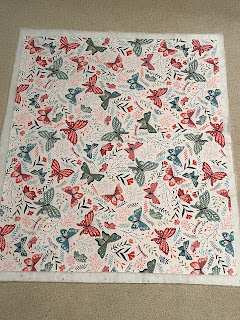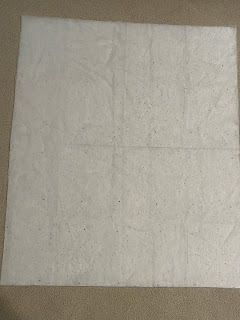The first process we need to learn before we start quilting is layering and basting the quilt. I do not wash the fabric before I quilt. In my opinion, the shrinking that occurs with the first wash AFTER quilting makes the quilted sections stand out better. You may wish to iron the fabric if it's very creased or wrinkled. I did not iron this fabric, for the sake of time, and it still turned out well as you can see in the image below, which shows the finished product of the layering and basting process. Please read all the instructions for this tutorial before you begin.
This process doesn't take long, but it is an important step before quilting can begin. Read my hand-quilting tools post first if you haven't done that yet. Then you can begin this process. Again, for this first lesson, we will be hand quilting a print. Spray basting saves a lot of time, but it does need to be done in a well ventilated area.
- First, cut the back/bottom fabric so the edges are squared up.
- Second, cut the top/front fabric so its edges are squared up. It should be 1 1/2 to 2 inches shorter from each edge of the backing, because the backing will also serve as our binding when we finish the quilt.
- Cut the batting (or fleece if you've decided to use that in the center of your quilt) slightly larger than the back fabric. Lay it on top of the back fabric. The printed (right) side of the fabric should be lying against the flat surface it is on.
- The next step is to pull the top half of the batting down to reveal the non-printed (wrong) side of the back fabric. Spray the basting onto the fabric. Then place the batting back over the fabric and firmly press it with your hands so that it adheres to the back fabric. It may not be a strong adhesion because quilt basting allows for re-adjustments. But it will hold the fabric and batting together good enough for quilting the layers later. AND the basting does wash out when you wash the quilt after completion.
- Next, pull the bottom half of the batting up so you can spray the basting onto the bottom section of the backing. After spraying, place the batting back over the backing and, with your hands, press the batting against the backing.
- After that is completed, cut the excess batting so that it is even with the edges of the back fabric - as is shown in the next two images.
- The next thing to do is to center the top fabric over the batting/backing combo. Repeat the basting process above with the top piece.
- You're finished spray basting the layers of the quilt together.
I hope this tutorial was helpful. If you have questions, feel free to email me. I'll be happy to help.
#quilting
#womenhelpingwomen
Blessings,
Patricia











Comments
Post a Comment
Thank you for taking time to leave a comment. Your comment will be published after it has been moderated. All SPAM is deleted by Blogger.